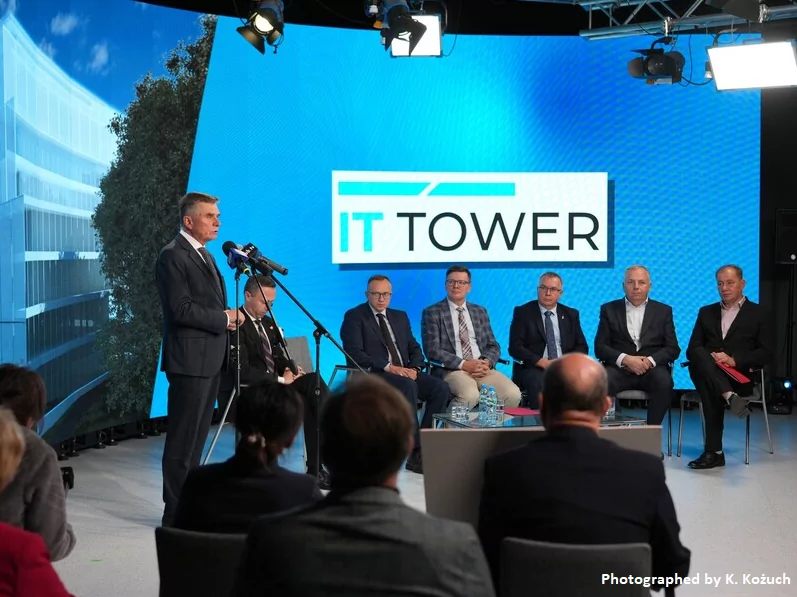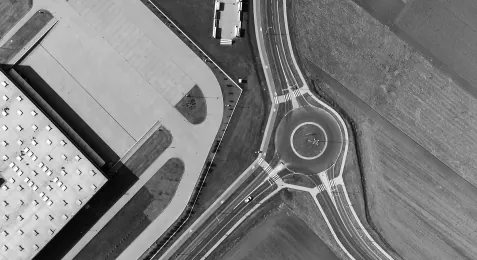Lublin Info Centre
Lublin University of Technology’s IT Tower: The future of AI and cybersecurity

IT Tower is poised to become an interdisciplinary centre for artificial intelligence and cybersecurity, where emerging scientific disciplines will be nurtured. This hub will drive advancements in technologies that are increasingly vital today, such as cloud technologies, big data, the Internet of Things, robotics, and various aspects of computer science. Addressing this significant challenge is crucial as Poland currently lags behind, with only 4 robots per 1000 residents, while the EU average stands at 14. This underscores the urgency of our efforts to bridge this technological gap.
The building will feature modern, well-equipped laboratories, but most importantly, it will be home to individuals who will tackle new challenges, embark on innovative projects, and devise solutions that will eventually benefit the city and the region, said Professor Dr Zbigniew Pater, Rector of Lublin University of Technology.
During the ceremony, Artur Soboń, Deputy Minister of Finance, handed over a symbolic check for IT Tower’s construction, expressing confidence that the 100 million Polish zlotys allocated to Lublin University of Technology will not only enhance the university’s development but also solidify Lublin’s position as a hub for artificial intelligence in Poland.
The construction of IT Tower aligns perfectly with Poland’s development strategy, as well as Lublin and the region. We are no longer an economy that competes solely based on low labour costs. We are an economy that attracts technologically advanced projects and competes on productivity, innovation, and new solutions that we aim to showcase and sell not only within Poland but also beyond its borders, emphasizes Minister Soboń.
Michał Mulawa, the Deputy Marshal of the Lubelskie Voivodeship, echoed this sentiment, underlining Lublin and the Lubelskie region’s readiness to become a centre for artificial intelligence and a fertile ground for nurturing IT skills and competencies. IT Tower is expected to host highly specialized personnel who will drive the region’s economic transformation toward intelligent specializations.
Lech Sprawka, the Lubelskie Voivode, emphasized the importance of technical education in preparing a workforce for IT Tower.
We are currently collaborating to establish an educational hub in primary and secondary schools, focusing on six subjects: physics, chemistry, biology, geography, mathematics, and computer science. Graduates from these schools will be a valuable resource for IT Tower.
IT Tower’s construction represents not only a significant investment in the Lublin University of Technology but also a vital step towards positioning Lublin as a prominent centre for artificial intelligence and technology development in Poland, fostering innovation, and contributing to regional and national growth. The project is expected to be completed by 2028, marking a transformative milestone for the university, the city, and the region.
Cybersecurity and AI hub for the Lubelskie Voivodeship
The idea behind establishing the Interfaculty Center for Cybersecurity and Artificial Intelligence was to provide advisory services to industries, as elucidated by Professor Dariusz Czerwiński, the head of the Department of Applied Computer Science:
The centre will offer services related to maintaining digital security, from assessing an entity’s current security measures to identifying potential cyber threats and devising customized plans for remedial actions and their implementation. Our expertise in these domains is already being utilized through initiatives like the Lublin Digital Union and the Regional Center for Digital Medicine.
Investment in students
The new building will cater to the education of future engineers and master’s students specializing in computer science:
This programme has been active at the university for 23 years, producing 300 new IT specialists annually. However, the current and future demand for IT professionals surpasses our current capacity. We are unable to prepare enough graduates to meet the employment opportunities available in companies within the Lubelskie Voivodeship. Thanks to this investment, we will be able to educate at least 20% more IT students annually, explained Professor Paweł Węgierek, the dean of the Faculty of Electrical Engineering and Computer Science.
The university plans to introduce programmes in technical informatics and cybersecurity, providing students in these fields with facilities in the new building.
Accessible and environmentally friendly space
The new building will be situated along Nadbystrzycka Street and the central axis of the campus, which currently serves as a parking area. The architectural concept was developed by architects from Lublin University of Technology: Dr. Eng. Arch. Bartłomiej Kwiatkowski and MSc Eng. Arch. Karol Krupa. Construction work spanned nearly two years.
The building will stand at a height of approximately 30 meters, comprising 10 stories – 8 above ground and 2 below. Its total surface area will encompass 12,000 square meters, with a volume of 39,000 cubic meters. Internally, the structure will house lecture halls, seminar rooms, and 3 auditoriums, each accommodating 120-300 people. There will also be facilities for students, including spaces for academic societies, individual workrooms, reading rooms, and relaxation zones. The building will incorporate 30 general and specialized laboratories, administrative offices, and technical facilities.
The building will be equipped with an advanced computerized organizational support system, ensuring easy access to information regarding room availability. Furthermore, all areas within the building will be designed to accommodate individuals with limited mobility, as well as those with visual and hearing impairments. To enhance the overall experience, public spaces will also feature designated “relaxation corners, as highlighted by Dr. Eng. Arch. Bartłomiej Kwiatkowski, one of the architects responsible for the building’s concept.
In keeping with a commitment to environmental sustainability, IT Tower’s construction will employ eco-friendly materials. The architectural plan includes the incorporation of green terraces, the efficient use of “grey water” for various purposes, and protective measures aimed at preventing bird collisions with the extensive glass facades.
The building is being designed to withstand the impacts of climate change. To achieve this, it will feature heat-resistant facades, automatic blinds on the glass walls for temperature control, and an integrated photovoltaic system with energy storage. These measures will ensure that IT Tower is a symbol of sustainability and adaptability.






